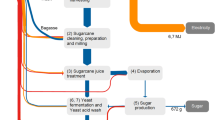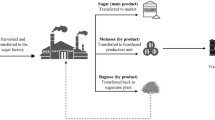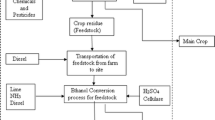Abstract
This work presents detailed life cycle assessment (LCA) of a novel process to produce ethanol from rice straw in India. The process has been successfully demonstrated and proposed to be scaled-up, and detailed LCA of that process is the key novel contribution of this work. Cradle-to-gate system boundary is considered, which includes rice farming, transportation, and processing at the biorefinery. 1 l of ethanol is used as the functional unit. The process data are based on the demonstration-scale plant as well as the scale-up plant of 100 kilo litres per day being designed based on the same process. The life cycle inventory data are taken from the Ecoinvent® database. OpenLCA 1.6 is used to develop the LCA model, and impact assessment is performed using ILCD 2011 midpoint indicators. The GWP was 2.82 kg of CO2 eq. per liter of ethanol using economic impact allocation. Electricity contributed 86% of the total impact, and use of hydroelectricity reduced the impact to 0.07 kg of CO2 eq. per liter of ethanol. If additional benefits due to this process are considered, the impact reduced to − 0.392 kg of CO2 eq. per liter of ethanol indicating considerable relative reduction in the GWP. Without allocation and implementing system expansion, the impact was 3.35 kg of CO2 eq. per liter of ethanol. The energy return on investment was 1.59, indicating that the process was net energy positive. The lower bound on the life cycle water use was 507.4 l per liter of ethanol. The integrated nature of the process producing various value-added chemicals provided significant benefits from the perspective of environmental impacts.
Graphic abstract





Similar content being viewed by others
References
Achten WMJ, Almeida J, Fobelets V, Bolle E, Mathijs E, Singh VP et al (2010) Life cycle assessment of Jatropha biodiesel as transportation fuel in rural India. Appl. Energy 87:3652–3660
Ahlgren S, Björklund A, Ekman A, Karlsson H, Berlin J, Börjesson P et al (2015) Review of methodological choices in LCA of biorefinery systems—key issues and recommendations. Biofuels Bioprod. Biorefin. 9:606–619
Aradhey A, Sindelar S (2017) India: Biofuels Annual 2017. IN7075
Borrion AL, McManus MC, Hammond GP (2012) Environmental life cycle assessment of lignocellulosic conversion to ethanol: A review. Renew. Sustain. Energy Rev. 16:4638–4650
Chiu Y-W, Wu M (2012) Assessing county-level water footprints of different cellulosic-biofuel feedstock pathways. Environ. Sci. Technol. 46(16):9155–9162
Cox PM, Betts RA, Jones CD, Spall SA, Totterdell IJ (2000) Acceleration of global warming due to carbon-cycle feedbacks in a coupled climate model. Nature 408(6809):184–187
Dale B (2015) A new industry has been launched: The cellulosic biofuel ship (finally) sails. Biofuel Bioprod. Bioref. 9:1–3
Dominguez-Faus R, Powers SE, Burken JG, Alvarez PJ (2009) The water footprint of biofuels: a drink or drive issue? Environ. Sci. Technol. 43:3005–3010
Evans EJ, Li H, Han S, Henkelman G, Buddie Mullins C (2019) Oxidative cross-esterification and related pathways of co-adsorbed oxygen and ethanol on Pd–Au. ACS Catal. 9(5):4516–4525
Gerbens-Leenes W, Hoekstra AY (2011) The water footprint of biofuel-based transport. Energy Environ. Sci. 4:2658–2668
Gerbrandt K, Chu PL, Simmonds A, Mullins KA, MacLean HL, Griffin WM et al (2016) Life cycle assessment of lignocellulosic ethanol: a review of key factors and methods affecting calculated GHG emissions and energy use. Curr. Opin. Biotechnol. 38:63–70
Government of India (2008) National policy on biofuels.
IPCC (2007) Climate Change: The physical science basis. Contribution of Working Group I to the Fourth Assessment Report of the IPCC. In: Solomon S, Qin D, Manning M, Chen Z, Marquis M, Averyt, KB, Tignor M, and Miller HL, Eds. Cambridge, UK: Cambridge University Press.
ISO (2006a) ISO 14040 International Standard. Environmental management—Life Cycle Assessment—Principles and framework.
ISO (2006b) ISO 14040 International Standard. Environmental management—Life Cycle Assessment – Requirements and guidelines.
Kadam KL (2002) Environmental benefits on a life cycle basis of using bagasse-derived ethanol as a gasoline oxygenate in India. Energy Policy 30:371–384
Khatiwada D, Silveira S (2011) Greenhouse gas balances of molasses based ethanol in Nepal. J. Clean. Prod. 19:1471–1485
Li, H., Chai, W., & Henkelman, G. (2019). Selectivity for ethanol partial oxidation: the unique chemistry of single atom alloy catalysts on Au, Ag, and Cu(111). J. Mater. Chem. A.
Mandade P, Bakshi BR, Yadav GD (2015) Ethanol from Indian agro-industrial lignocellulosic biomass: a life cycle evaluation of energy, greenhouse gases, land and water. Int. J. Life Cycle Assess. 20:1649–1658
Mathioudakis V, Gerbens-Leenes PW, Van der Meer TH, Hoekstra AY (2017) The water footprint of second-generation bioenergy: a comparison of biomass feedstocks and conversion techniques. J. Clean. Prod. 148:571–582
Mitavachan H, Srinivasan J (2017) Multi-criteria sustainability assessment of coal and solar power generation in India. Curr. Sci. 113:1034–1038
Morales M, Quintero J, Conejeros R, Aroca G (2015) Life cycle assessment of lignocellulosic bioethanol: Environmental impacts and energy balance. Renew. Sustain. Energy Rev. 42:1349–1361
Raich JW, Schlesinger WH (1992) The global carbon dioxide flux in soil respiration and its relationship to vegetation and climate. Tellus B 44(2):81–99
Shastri Y (2017) Renewable energy, bioenergy. Curr. Opin. Chem. Eng. 17:42–47
Shonnard DR, Klemetsrud B, Sacramento-Rivero J, Navarro-Pineda F, Hilbert J, Handler R et al (2015) A review of environmental life cycle assessments of liquid transportation biofuels in the Pan American region. Environ Manage 56:1356–1376
Soam S, Borjesson P, Sharma PK, Gupta RP, Tuli DK, Kumar R (2017) Life cycle assessment of rice straw utilization practices in India. Bioresour Technol 228:89–98
Soam S, Kapoor M, Kumar R, Borjesson P, Gupta RP, Tuli DK (2016) Global warming potential and energy analysis of second generation ethanol production from rice straw in India. Appl Energy 184:353–364
Soam S, Kumar R, Gupta RP, Sharma PK, Tuli DK, Das B (2015) Life cycle assessment of fuel ethanol from sugarcane molasses in northern and western India and its impact on Indian biofuel programme. Energy 83:307–315
Sukumaran RK, Surender VJ, Sindhu R, Binod P, Janu KU, Sajna KV et al (2010) Lignocellulosic ethanol in India: prospects, challenges and feedstock availability. Biores Technol 101:4826–4833
Varshney D, Mandade P, Shastri Y (2019) Multi-objective optimization of sugarcane bagasse utilization in an Indian sugar mill. Sustain Prod Consum 18:96–114
Wiloso EI, Heijungs R, de Snoo GR (2012) LCA of second generation bioethanol: a review and some issues to be resolved for good LCA practice. Renew Sustain Energy Rev 16:5295–5308
Xie X, Zhang T, Wang L, Huang Z (2017) Regional water footprints of potential biofuel production in China. Biotechnol Biofuel 10:95
Zanchet D, Santos JBO, Damyanova S, Gallo JMR, Bueno JMC (2015) Toward understanding metal-catalyzed ethanol reforming. ACS Catal 5:3841–3863
Acknowledgements
The first two authors would like to acknowledge the Department of Biotechnology (DBT), Government of India, for funding this research through grant BT/EB/PAN IIT/2012. The last three authors would also like to acknowledge the Department of Biotechnology (DBT), Government of India, for funding the research. The authors would also like to acknowledge India Glycols Ltd., Kashipur, India, for sharing plant data.
Author information
Authors and Affiliations
Corresponding author
Additional information
Publisher's Note
Springer Nature remains neutral with regard to jurisdictional claims in published maps and institutional affiliations.
Rights and permissions
About this article
Cite this article
Sreekumar, A., Shastri, Y., Wadekar, P. et al. Life cycle assessment of ethanol production in a rice-straw-based biorefinery in India. Clean Techn Environ Policy 22, 409–422 (2020). https://doi.org/10.1007/s10098-019-01791-0
Received:
Accepted:
Published:
Issue Date:
DOI: https://doi.org/10.1007/s10098-019-01791-0




